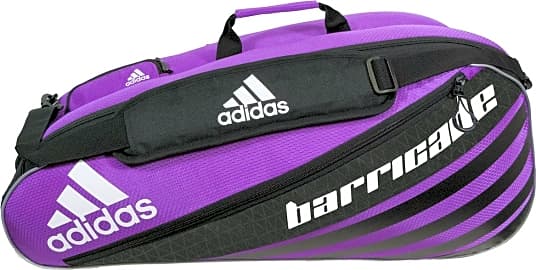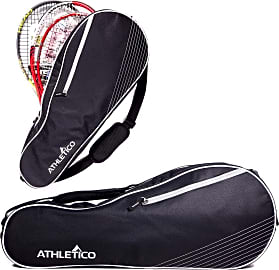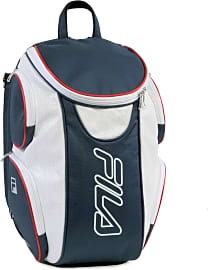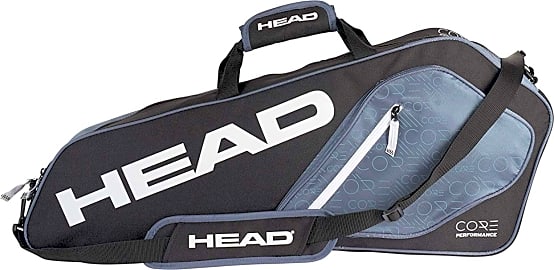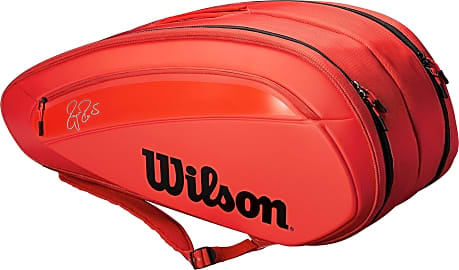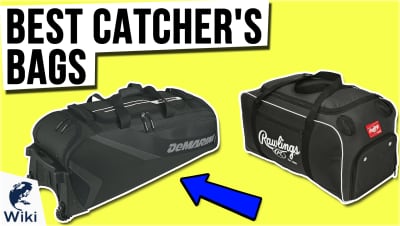The 10 Best Tennis Bags

This wiki has been updated 36 times since it was first published in October of 2016. Getting in a game of tennis can be challenging, given all the gear you have to lug around, like rackets, balls, towels, and more. These bags are thoughtfully designed with plenty of pockets for your essentials, and they come in many styles and sizes. They make it easy to corral all of your stuff, so you can focus on other important things, like arguing about whether that serve was out or not. When users buy our independently chosen editorial picks, we may earn commissions to help fund the Wiki.
Editor's Notes
April 07, 2021:
I’m a huge fan as well as an avid player of racquet sports – well, not so much squash, but tennis and badminton, so I’ve been looking forward to make my contribution to this category. I’ve replaced a few options in this list so that it includes only more serious options, nearly all of which are going to be duffel-style bags, and a couple of backpacks like the Fila Ultimate - as well as the Wilson Federer, which comes in a backpack option. Regardless, all of these options – many of which are made by tennis companies, like Wilson and Head - are now more or less designed as tennis bags, and are not simply multipurpose gym bags that are being marketed as tennis bags, though many can be used for that purpose too. I’m keen on both the Head 3R and Wilson Federer, as I personally like something that’s a little aesthetically pleasing, even if it’s a little more expensive, because it improves my incentive to play.
February 26, 2020:
Whether you’re a club player or you play for fun, our list has got a sturdy tennis bag for you. Today we added in another stylish option to our list: the Court Couture Cassanova. It joins the Cinda B. Tote II and the Maggie Mather as bags that look just as good around town as they do on the tennis court. This one features a dedicated sleeve on the front to hold your racket, as well as plenty of interior room for your necessities. It also comes with a matching cosmetics case and a decorative tassel. It features a timeless houndstooth pattern, a matching striped lining, and protective metal feet.
Other new additions are the Wilson Advantage and the Babolat Club Line 6, which are just as functional as a tote bag, but sportier in nature. Both can hold multiple rackets, and feature comfortable carrying handles on top. For a versatile choice with multiple carrying options, look to the Head Core 6R, which has a top handle and also a removable, padded shoulder strap.
If you prefer to have your arms free, consider a tennis backpack like the Fila Ultimate or the Wilson Federer, both of which can double as a school bag and are available in multiple attractive color combinations.
A Brief History Of Tennis
If horse racing is the sport of kings, then tennis may just be the sport that kills those kings graveyard dead.
If horse racing is the sport of kings, then tennis may just be the sport that kills those kings graveyard dead. I know, that seems like a bold way to start a history of tennis, but the game's past is much richer and more dangerous than you might expect.
Its origins trace back to 12th century France and a game which involved hitting a ball against a wall or over a rope with your bare hand. This precursor, called real tennis, rapidly evolved, and soon participants used racquets and played in enclosed areas.
The sport claimed its first regal victim in 1437, when the Scottish monarch King James I was murdered by assassins. He had attempted to elude his attackers through sewage drain, only to find that it had been plugged due to the fact that tennis players had lost too many balls inside of it.
Tennis spread like wildfire through the French nobility, thanks in large part to avid fan King Francis I. However, the deadly sport would continue its regicidal ways, taking down Louis X after he caught a chill while playing and vanquishing Charles VIII after he hit his head mid-game. Despite its ability to kill off government officials (or maybe because of it), the game continued to grow in popularity.
In 1874, Major Harry Gem and Augurio Perera founded the first tennis club in Birmingham, England. The game as they played it combined real tennis with the Spanish racket game pelota, and it was played on a croquet lawn.
The sport crossed the pond into America in 1874, with the first tournaments in the country held later that year. The biggest competition of them all, Wimbledon, was first played in 1877 as a way to raise money for the All England Club. The U.S. Open would follow four years later, with the final two Grand Slam events coming in the subsequent two decades.
It was played in the Athens Olympics in 1896, and while professionals were initially banned from playing in the Grand Slam events, they managed to earn a living by touring and playing exhibitions. Finally, in 1968, the "Open era" began, with pros starting their own circuits and dominating the major tournaments.
Today, tennis is played all over the world, and the top stars can make a fortune during their careers. The sport has been wildly successful, both in terms of its popularity and its ability to make kings increasingly rare across the globe.
Choosing The Right Tennis Bag
If you're an avid player, then you'll want to find a nice tennis bag to keep your gear organized both on and off the court. After all, tennis can be an expensive hobby — and even more so if you're careless with your equipment.
Some models have isothermal protection to keep your gear safe from the elements, while others utilize molded shells to spare them any impact damage.
In fact, protection should be one of your primary considerations when considering which option to buy. You want to make sure that it has enough padding to safeguard your racquets, especially if you tend to be rough when transporting them. Some models have isothermal protection to keep your gear safe from the elements, while others utilize molded shells to spare them any impact damage.
Next, consider just how much gear you carry around with you. If you cycle through several racquets every session, then make sure your bag is big enough to accommodate all of them. Also, don't forget to factor in balls, towels, water bottles, clothes — the whole nine yards. A little extra room is vastly preferable to having to leave something important behind.
Another thing to keep in mind is how you want to carry it. These things can get pretty heavy when full, so make sure that it's comfortable to lug around, especially if you have a lengthy trek to the court. Some allow you to strap them on like backpacks, which may be gentler on your frame than the traditional shoulder-strap bags, but it's all a matter of personal preference. Just remember that you don't want to be sore before you start playing, so get something that's easy on your joints.
After all, you're supposed to grunt when hitting the ball, not when carrying your equipment around.
What Should You Keep In Your Bag?
It may not seem like a big decision, but packing your tennis bag is no easy task. Some people see all that empty space and stuff it with items they aren't likely to need, while others are habitual under-packers, and find themselves missing vital items once they reach the court.
Luckily, I'm here to provide you with a list of essentials that every well-stocked bag requires.
First, make sure you have at least two racquets. This is so you'll have a spare in case you blow some strings during the match, and also because you'll want to play with both equally to maintain a similar feel.
You may not need them, but if you do, you'll definitely be glad you have them.
In addition, make sure you have plenty of balls with you so that you're never smacking around old, worn-out orbs, which can lead to tennis elbow. Also, it should be obvious that you'll find it extremely difficult to keep playing if you run out of balls.
Keep spare clothes in your bag, as well. You never know when you'll need a hat to block out the sun, or when you'll need to swap out your shoes to avoid blisters. On a related note, throw some bandages in there, too. You may not need them, but if you do, you'll definitely be glad you have them.
If you play with grips or a vibration dampener, then you'll want to have spares on hand, as having to soldier on without them can really throw off your game.
Finally, make sure you have food and water. Tennis is an extremely demanding sport, and you don't want to get seriously dehydrated or, even worse, lose because you're hungry. Having a banana or a can of peanuts to snack on in between games could be the difference between winning the match and getting kicked out of the club for smashing your racquet in a hunger-fueled rage.



